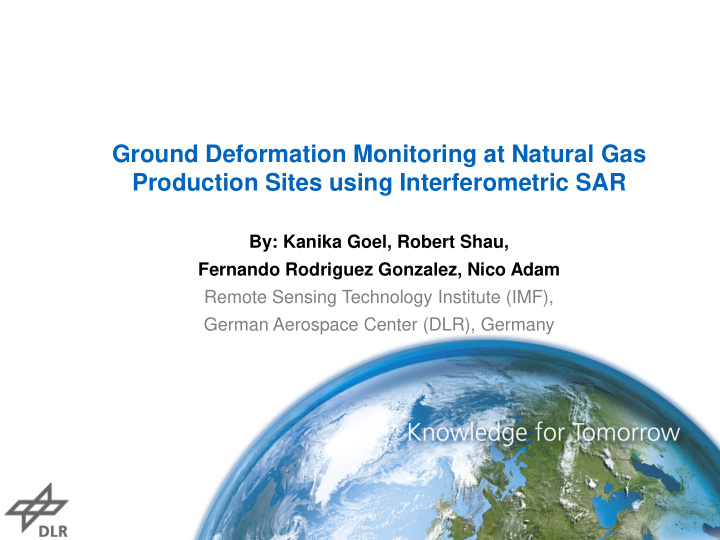



Ground Deformation Monitoring at Natural Gas Production Sites using Interferometric SAR By: Kanika Goel, Robert Shau, Fernando Rodriguez Gonzalez, Nico Adam Remote Sensing Technology Institute (IMF), German Aerospace Center (DLR), Germany
Introduction
Motivation Natural gas production has increased significantly to meet energy demands Extraction leads to decreased reservoir pressure and may cause subsidence Monitoring this subsidence important for geological and hazard analysis Ground deformation illustration
Natural Gas in Germany Small volumes produced as compared internationally In 2007, 17% domestic consumption from domenstic production Lower-Saxony accounted for 93% of German natural gas production BGR, Germany, collaborating with DLR for monitoring subsidence due to natural gas extraction Source: BGR, Germany
Interferometric SAR (InSAR) s Powerful remote sensing technique m for detecting ground deformation Deformation estimation using 2 SAR images and Digital Elevation Model (DEM) Interferogram phase contributions: Deformation
C-Band SAR Medium resolution of 25 m 5.6 cm wavelength 100 km swath width ERS
X-Band SAR High resolution of up to 1 m 3.1 cm wavelength High sensitivity to even millimetric displacements TerraSAR-X (TSX)
Methodology
Persistent Scatterer Interferometry (PSI) Coherent InSAR stacking technique Permanently coherent PSs exploited Differential interferograms wrt a single master image used PS Model-based deformation estimation
DLR‘s Integrated Wide Area Processor (IWAP) Highly automated, efficient and robust multi-sensor PSI-GENESIS software Successful demonstration and validation during ESA's Terrafirma project Greece Turkey Source: Rodriguez Gonzalez et al., 2013
PSI Algorithm PSs Detection PSs Reference Network Estimation Atmospheric Phase Screen (APS) Estimation and Removal PSs Final Network Estimation
PSI Algorithm PSs Detection PSs Reference Network Estimation Atmospheric Phase Screen (APS) Estimation and Removal PSs Final Network Estimation
PSs Reference Network Estimation- Block Processing Division of scene into overlapping blocks Blockwise creation of reference network (arcs connecting the PSs) Blockwise estimation of relative deformation and residual DEM for the arcs using LAMBDA estimator Blockwise network inversion to estimate d ef ormation and residual DEM for the PSs using least squares Illustration of block adjustment network Developed by: Werner Liebhart Merging of independently estimated blocks via least squares adjustment
PSs Reference Network Estimation- Single Network Creation of reference network (arcs connecting the PSs) Estimation of relative deformation and residual DEM for the arcs using LAMBDA estimator Mitigates error propagation Single network inversion to estimate d ef ormation and residual DEM for the PSs using least squares High computational load and memory consumption
PSs Reference Network Estimation- Single Network Sinlge network inversion- Strategies: Solve A x = B => A T A x = A T B A T A is symmetric positive definite square matrix Exploit sparsity of A => A T A Use QR or LU decomposition for fast inversion, instead of SVD decomposition Use a parallelizable solver Estimate deformation, residual DEM and standard deviation of estimates
PSs Reference Network Estimation- Single Network Example matrix A dimensions: TerraSAR-X Stripmap: Size(A) = (30000, 600000) ERS: Size(A) = (90000, 1800000) Sentinel-1: Size(A) = (450000, 9000000)
PSs Reference Network Estimation- Single Network Example matrix A T A dimensions: Example matrix A dimensions: TerraSAR-X Stripmap: TerraSAR-X Stripmap: Size(A T A) = (30000, 30000) Size(A) = (30000, 600000) ERS: ERS: Size(A T A) = (90000, 90000) Size(A) = (90000, 1800000) Sentinel-1: Sentinel-1: Size(A T A) = (450000, 450000) Size(A) = (450000, 9000000)
Application Test Case and Results
TSX Data- Ascending Stripmap Stack
Time – Baseline Plot
Master Amplitude Image
Interferogram Examples
Deformation Estimation Results -5 [mm/Jahr] +5
Area A Deformation Time Series Example
PSs Reference Network Estimation- Block Processing
PSs Reference Network Estimation- Block Processing
PSs Reference Network Estimation- Block Processing Residual topography Deformation -20 mm +20 -5 mm/yr +5
PSs Reference Network Estimation- Single Network Residual topography Deformation -20 mm +20 -5 mm/yr +5
PSs Reference Network Estimation- Difference Residual topography Deformation -20 mm +20 -5 mm/yr +5
PSs Reference Network Estimation- Deformation Variance Block processing Single network (mm/yr) 2 (mm/yr) 2 0 0.01 0 0.1
Summary
Conclusion and Outlook PSI powerful and cost-effective tool for monitoring the impact of hydrocarbon reservoirs Single reference network inversion has potential to improve the deformation velocity maps Comparison with GPS data would be performed in the future to validate the pilot study Sentinel-1 data would be acquired for large area monitoring
Sentinel-1 Thank you… Any questions?
PSs Reference Network Estimation- Scatter Plot -> Single Network -> Single Network -> Block processing -> Block processing Residual topography Deformation
PSs Reference Network Estimation- Scatter Plot -> Single Network -> Single Network -> Block processing -> Block processing Residual topography Deformation
Recommend
More recommend